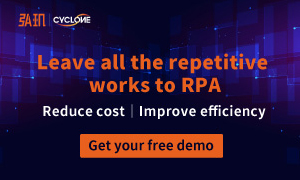At the moment of digital transformation, all walks of life are looking for ways to improve work efficiency and tools to follow the pace of digitalization. And Robotic Process Automation (RPA) is undoubtedly the best choice for the digital age and even the future trend! What is RPA? The full name of RPA is Robotic Process Automation (Robotic Process Automation). In this way, if there is too much interaction between work information and business, RPA can efficiently solve these complex processes and save labour costs. Today, RPA has become the most widely used, most effective and highly mature intelligent software. Many enterprises want to deploy RPA that suits them. RPA is a new technology concept with high-end automation capabilities and low entry barriers. It will promote the widespread use of robots in the process industry and bring huge economic benefits to society. In other words, Robotic Process Automation is a type of software that imitates human actions. It works in the background and does not require any human interference. The main purpose of RPA is to increase the efficiency of business processes and reduce costs. RPA can be used as a tool for managing business processes, but it can also be used as a platform for developing new applications. The benefits of RPA are many and include: 1. Improve Accuracy Robotic Process Automation eliminates human error by eliminating humans from the equation. This leads to improved accuracy in data collection, processing and analysis. Meanwhile, RPA can handle large volumes of data quickly and accurately, which ensures that all information is processed accurately and promptly. 2. Reduce Costs RPA provides a cost-effective solution for automating manual processes that would otherwise require human capital, which is often extremely expensive when compared with using RPA software. With the help of RPA automation, one can reduce the operational cost of manual tasks. People no longer have to do those repetitive, boring tasks, they are free to complete more valuable tasks. 3. Improve Customer Service RPA helps improve customer service by reducing wait times and increasing customer satisfaction with faster responses to inquiries and lower error rates on transactions. 4. Improve Efficiency RPA can be used to automate repetitive tasks such as data entry, data manipulation and data extraction for manual workflows. Through the use of technology and software, RPA can reduce the costs of performing these tasks by up to 90%. 5. More Flexibility The software is flexible enough that it can be used across multiple industries and processes, which means that you don’t have to worry about switching providers if your business changes or grows over time. RPA helps improve customer service by reducing wait times and increasing customer satisfaction with faster responses to inquiries and lower error rates on transactions. Robotic Process Automation is applied more like an intelligent digital employee than a rigid software system. Digital workers are also called "digital robots". Different from traditional physical robots, a digital robot is not a real robot that can be seen by the naked eye, but a software robot running on the computers and mobile phones of business personnel. People automate office operations by simulating mouse clicks, keyboard input, and reading information. Technologies such as big data, artificial intelligence, and cloud computing have empowered Robotic Process Automation with the ability to “digital workers.” As a digital worker, RPA can be applied in all walks of life. Here are a few examples to demonstrate the capabilities of this outstanding employee of RPA: I believe everyone agrees: every job has inevitable repetitive work, either entering information or querying information. If you are the owner of an insurance company, your employee A is very attentive when inquiring about the insurance practice certificate information. Normally, employee A takes at least 1 minute to make a query each time, but this job needs to be done at least 500 times a month. That means he or she needs at least 2 working days a month to complete this boring task. But if the job is to be done by a digital employee - RPA, it can complete these data entry queries in a dozen seconds. Because it is robotic thinking, it can directly understand the meaning of the data and enter it immediately. It doesn't need to make sense of data to work as humans do. Many companies will have some software for their industry. They can help employees get some work done. But in many cases, they use more than one software system. The trouble is that not all software systems have compatible formats, which can lead to some errors. These errors need to be handled manually, and the rigid operating system makes the job more difficult. For example, in the process of the manufacturing industry, the factory will monitor the information of the manufacturing site, and also need to schedule the site according to the information. But the manufacturing process is different for different products. The degree of software on the market, however, is mostly set. Having flexible software can be a big help at this point. Digital Employee B—RPA allows you to customize your process automation software. People can create their own software with low or no code. What a wonderful staff! Under the influence of digitization, more companies are facing information waterfalls consisting of thousands of pieces of information every day. This is undoubtedly extremely difficult for employees of the traditional era to find information from it. Because even if a person does not sleep, it is difficult to accurately find valuable information from the information waterfall. For example, you are the owner of a logistics company. During the shopping carnival, you have hundreds of thousands of goods in your warehouse waiting to be entered. At this time, digital employees can easily query information through big data technology and then organize it into a valuable document. Realize the integration and automation of data information. Why do we need Robotic Process Automation in the future? Because the future is the digital future. When the technology is ready, your customers, potential customers, competitors, and your employees are ready, then you should know: You must be ready too. So, please choose Cyclone to be your fighting partner: l Download the 100 + RAP Robot for free. They allow you to build a personal intelligent assistant in three minutes to help you work efficiently. l Help you to proceed with the digital transformation of your enterprise. Cyclone combines advanced AI technology to promote the digital transformation of enterprises. Meanwhile, it supports cross-system, cross-platform deployment to help you generate port-to-port super automation solutions. l Provide an automated workflow. Cyclone can provide automated technical support for companies to work in financial, human resources, supply chain and other scenarios. What are you waiting for? Come and try Cyclone's free robot! You will be pleasantly surprised!What are the Benefits of Robotic Process Automation(RPA)?
Meta Description:

What is Robotic Process Automation?
Robotic Process Automation provides more benefits and better service:
When and Where Do We Need a Robotic Process Automation?
1. Inefficiency vs Efficiency
2. Rigid operating system VS Flexible personalized design
3. Weak data collection capability of VS integrated information automation
Why Do We Need A Robotic Process Automation In The Future?
The advantages of Cyclone:
 中文
中文
Home>RPA Glossary
What are the Benefits of Robotic Process Automation(RPA)?
News source:
Number of Views:986人
Related recommendations
See more >
-
Benefits of RPA E-commerce Automation SolutionsRPA e-commerce automation solutions improves the user experience (through division and targeted products) while enabling companies to focus and create time for other critical duties that involve thinking and social competence. <2022-06-15
-
Types and benefits of RPA Manufacturing Automation SolutionsRPA Manufacturing Automation Solutions helps to lessen a company's need for trained laborers. Innovations in RPA automation are essential for the manufacturing industry because they enable organizations to maintain efficiency, and productivity. <2022-06-15
-
Telecom RPA Robot Assisting the Telecom IndustryAdopting the telecom RPA robot of the cyclone can assist telecom companies in overcoming many obstacles, therefore enhancing their company operations and giving them a competitive advantage.<2022-06-15
-
Robotic process automation in banking and its benefitsIt has contributed to the adoption of robotic process automation in the banking industry. Let's learn about different Bank RPA factors.<2022-06-10
- Email us
-
(+65) 6978 5830
Working Hours 09:00 - 18:00




